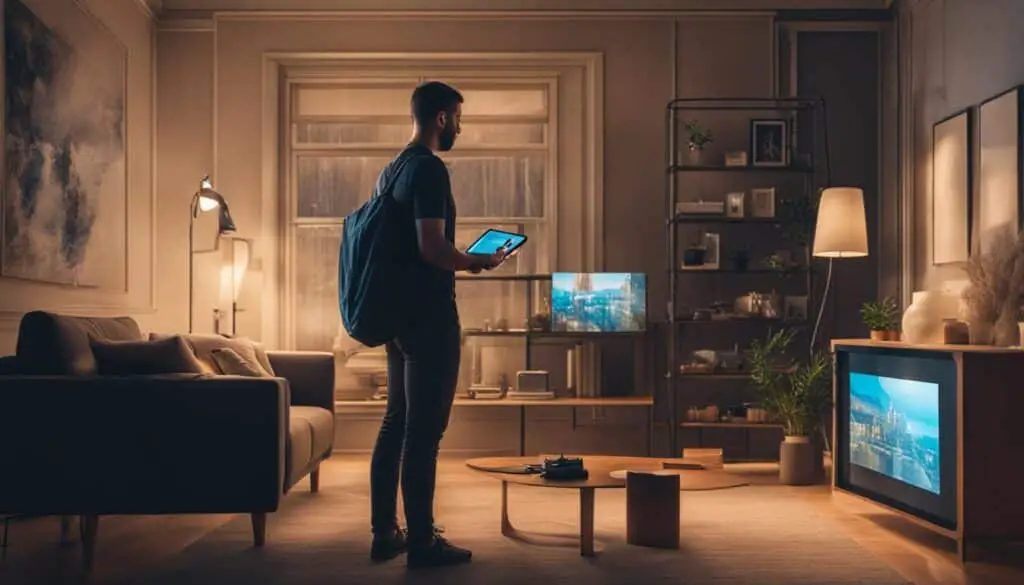Home automation is becoming increasingly popular as people look to make their houses smarter and more convenient. If you’re a beginner looking to dip your toes into the world of DIY home automation, this guide is for you. In this article, we will explore a variety of beginner-friendly projects that will help you transform your house into a smart home with ease and confidence. From choosing your first smart device to setting up a smart home platform and connecting more devices, we’ve got you covered. Let’s get started!
Table of Contents
Key Takeaways:
- DIY home automation projects are a great way for beginners to create a smart home.
- There are many simple and easy home automation projects suitable for beginners.
- Beginner-friendly smart home projects offer convenience, security, and energy efficiency.
- By following DIY home automation tutorials, beginners can learn and customize their smart home setup.
- With a little research and creativity, beginners can enjoy the benefits of a smart home.
What is a Smart Home?
A smart home utilizes smart devices to automate and control various household functions, offering convenience, security, entertainment, and energy efficiency benefits. Through the use of smart devices, homeowners can remotely control and automate different aspects of their homes, such as lighting, temperature, and security systems. Mobile apps and voice commands provide seamless control, making it easy to manage and monitor the smart home ecosystem.
In a smart home, interconnected devices communicate with each other, allowing for centralized control and coordination. For example, you can set up routines and schedules to automate tasks, like turning on the lights when you arrive home or adjusting the thermostat based on your preferences. Voice commands through virtual assistants such as Amazon Alexa or Google Assistant enable hands-free control, adding convenience to your daily life.

One of the key advantages of a smart home is the convenience it offers. With mobile apps, you can control and monitor your smart devices from anywhere, providing peace of mind and flexibility. Additionally, smart devices can enhance home security by allowing you to remotely monitor security cameras, lock doors, and receive notifications in case of any unusual activity. This brings an additional layer of security and protection to your home.
Entertainment is also elevated in a smart home environment. You can integrate smart speakers with your entertainment systems to stream music, podcasts, or videos using voice commands. With the ability to customize and personalize your smart home setup, you can create an immersive entertainment experience tailored to your preferences.
Moreover, energy efficiency is a significant advantage of a smart home. Smart devices like thermostats and lighting systems can be programmed to adjust settings based on occupancy, time of day, or energy-saving modes. This enables optimized energy consumption and reduced energy bills, contributing to a greener and more sustainable lifestyle.
| Benefits of a Smart Home |
|---|
| Convenience |
| Security |
| Entertainment |
| Energy Efficiency |
A smart home harnesses technology to provide a seamless and integrated living experience. With the use of smart devices, mobile apps, and voice commands, homeowners can enjoy the convenience, security, entertainment, and energy efficiency that a smart home offers. Investing in a smart home ecosystem allows you to transform your house into a modern, high-tech living space.
Choosing Your First Smart Device
When starting your DIY home automation journey, it’s important to choose your first smart device wisely. Consider your budget, opt for intuitive devices that match your skill level, and do some research before making a purchase. Read customer opinions and reviews, consult buyer’s guides, and compare different options to find the best smart device for your needs. Some popular options for beginners include smart home security systems, smart thermostats, smart outlets, smart lights, and virtual assistants like Amazon Echo or Google Nest Mini.
“It’s crucial to select a smart device that aligns with your budget and the level of complexity you’re comfortable with. Doing thorough research and reading customer opinions and independent reviews can provide valuable insights into the performance and reliability of different products.” – John Brown, DIY Home Automation Enthusiast
When considering your budget, it’s essential to strike a balance between cost and functionality. While higher-end smart devices may offer more advanced features, there are plenty of affordable options available that provide excellent performance for beginners. Additionally, choosing intuitive devices ensures a smoother setup process and a more intuitive user experience.
Reading customer opinions and reviews allows you to gauge the real-world performance and reliability of a particular smart device. It’s always beneficial to learn from the experiences of others who have already used the device you’re considering. Independent reviews and buyer’s guides can also offer valuable insights and recommendations based on expert opinions and thorough testing.
Remember, the goal is to find a smart device that meets your specific needs and preferences. Whether you’re looking to enhance home security, improve energy efficiency, or add convenience to your daily life, selecting the right smart device is crucial for a successful DIY home automation project.
Popular Smart Devices for Beginners
| Recommended Smart Device | Description |
|---|---|
| Smart Home Security Systems | Comprehensive security solutions that include cameras, sensors, and alarms to protect your home. |
| Smart Thermostats | Intelligent thermostats that allow you to control and automate your home’s temperature settings for optimal comfort and energy savings. |
| Smart Outlets | Wi-Fi-enabled outlets that let you control and schedule the power supply to your devices through a mobile app. |
| Smart Lights | Light bulbs that can be controlled remotely and customized to create ambiance through different colors and brightness levels. |
| Virtual Assistants (Amazon Echo, Google Nest Mini) | Smart speakers that can play music, answer questions, provide weather updates, and control other smart devices using voice commands. |

Choosing your first smart device is an exciting step towards creating a smarter home. Consider your needs, do your research, and make an informed decision that aligns with your budget and goals. With the right smart device, you can begin your DIY home automation journey with confidence!
Setting Up a Smart Home Platform
To effectively manage your smart devices and create a cohesive smart home experience, it’s recommended to set up a smart home platform. This platform allows you to centralize control of your devices through a smartphone, computer, or voice control using digital assistants like Google Assistant, Alexa, or Siri. There are different options for smart home platforms, including virtual hubs that link accounts of different Wi-Fi devices over the internet, as well as tangible hubs that control devices through protocols like Z-Wave and Zigbee. Consider compatibility and choose a platform that works with multiple smart home devices.
The Benefits of a Smart Home Platform
A smart home platform serves as a central control hub, providing convenient access and management of your smart devices. Here are some advantages of setting up a smart home platform:
- Centralized Control: With a smart home platform, you can control all your smart devices from one location, eliminating the need for multiple apps.
- Seamless Integration: A platform ensures compatibility between different devices, allowing them to seamlessly work together for a more cohesive smart home experience.
- Convenience: By using your smartphone, computer, or voice commands, you can easily control and automate various aspects of your home, such as lighting, thermostats, security systems, and more.
- Expanded Compatibility: A smart home platform offers compatibility with a wide range of devices, including popular brands like Google Assistant, Alexa, and Siri.
When choosing a smart home platform, consider the specific features and compatibility requirements of your devices. Some platforms may have limitations in terms of the types of devices they can control, so be sure to select a platform that works with your preferred devices.
Comparing Smart Home Platforms
| Platform | Central Control | Compatibility | Voice Control |
|---|---|---|---|
| Google Assistant | Yes | Works with a wide range of smart devices | Yes |
| Alexa | Yes | Works with a wide range of smart devices | Yes |
| Siri | Yes | Works with Apple HomeKit compatible devices | Yes |
When it comes to smart home platforms, three popular options are Google Assistant, Alexa, and Siri. Here’s a brief comparison:
- Google Assistant: Google Assistant provides central control and is compatible with a wide range of smart devices. It also offers voice control capabilities for hands-free operation.
- Alexa: Alexa, the virtual assistant from Amazon, offers central control and compatibility with various smart devices. With Alexa, you can control your smart home using voice commands.
- Siri: Siri is Apple’s virtual assistant, offering central control for Apple HomeKit compatible devices. It allows you to control your smart home using voice commands through Apple devices.
Each platform has its own strengths and compatibility requirements, so consider your ecosystem and device preferences when making a decision.
Setting up a smart home platform is a crucial step towards creating a convenient and connected smart home. It allows you to streamline control and integration, bringing all your smart devices under one umbrella. With options like Google Assistant, Alexa, and Siri, you can choose a platform that suits your needs and enjoy the benefits of a seamlessly automated home.
Connecting More Devices
Now that you have set up your smart home platform, you can further enhance your automation capabilities by connecting more devices. With the right devices and setups, you can create routines and schedules to automate tasks, making your smart home even smarter and more efficient.
Automation is key in a smart home. By setting up routines and schedules, you can make your home carry out specific actions at predefined times or in response to certain events. For example, you can create a routine to turn off all the lights and lock the doors when you leave the house, or schedule your smart thermostat to adjust the temperature before you wake up or arrive home.
Creating Automation Routines and Schedules
Creating automation routines and schedules is simple with most smart home platforms. These platforms offer user-friendly interfaces and intuitive settings that allow you to customize your automation rules. You can specify actions to be carried out by specific devices, set triggers based on time, location, or sensor inputs, and create complex sequences of events.
For example, using a smart home platform like Google Home, you can create a routine that turns on the lights, adjusts the thermostat, and plays your favorite morning playlist when you say “Good morning”. You can also set a schedule to automatically turn off all the lights and lower the thermostat at bedtime.
Automation routines and schedules can greatly simplify your daily routines and add convenience to your life. They allow you to focus on more important tasks while your smart home takes care of mundane activities.
Choosing Compatible Devices
When adding more devices to your smart home setup, compatibility is crucial. Make sure the devices you choose are compatible with your smart home platform and can seamlessly integrate into your existing automation routines and schedules.
Here are some popular devices that you can consider integrating into your smart home:
| Device | Description |
|---|---|
| Smart Speakers | Devices like Amazon Echo and Google Home that allow voice control and act as a central hub for your smart home. |
| Smart Locks | Locks that can be controlled remotely, allowing you to lock and unlock your doors using your smartphone or voice commands. |
| Smart Thermostats | Thermostats that can be programmed and controlled remotely, helping you save energy and maintain optimal temperature settings. |
| Smart Light Bulbs | Light bulbs that can be dimmed, color-changed, or controlled remotely, providing convenience and energy efficiency. |
| Smart Plugs | Plugs that can be controlled remotely, allowing you to turn on or off any device connected to them. |
These devices offer various functionalities and can be seamlessly integrated into your smart home platform. Choose devices that best suit your needs and enhance the automation experience in your home.
With the right devices and careful planning, you can build a smart home that is not only convenient and efficient but also customizable to your preferences and lifestyle.
Popular Smart Devices for Beginners
When it comes to transforming your home into a smart and connected oasis, there are countless options available in the market. These smart devices not only offer great functionality but are also beginner-friendly, making them perfect for those just starting their journey into home automation. Whether you’re looking to enhance security, add convenience, or create a more energy-efficient environment, these popular smart devices are sure to meet your needs.
Smart Home Security Systems
One of the top priorities for any homeowner is the security of their property. Smart home security systems, such as Vivint, provide comprehensive protection and peace of mind. With features like motion detection, real-time alerts, and remote monitoring, you can keep a watchful eye on your home from anywhere. These systems offer seamless integration with other smart devices, creating a robust security ecosystem.
Smart Thermostats
Efficiently managing your home’s temperature is made easy with smart thermostats like the Google Nest Learning Thermostat. These intelligent devices learn your temperature preferences and adjust accordingly, saving energy and reducing costs. With the ability to control your thermostat from anywhere using your smartphone, you can ensure a comfortable environment while maximizing energy efficiency.
Smart Locks
Never worry about losing your keys again with smart locks such as the Schlage Encode. These locks offer keyless entry, allowing you to unlock your door using a smartphone app or a unique access code. You can also receive notifications when someone enters or exits your home. Smart locks provide an added layer of security and convenience for you and your family.
Smart Outlets
Transform any outlet into a smart outlet with devices like the Kasa Smart Outlet. These outlets enable you to control connected appliances and devices remotely. Whether you want to turn off the lights or schedule your coffee maker to start brewing in the morning, smart outlets give you the power to automate and control your home with ease.
Smart Lights
Create the perfect lighting ambiance in your home with smart lights like the Philips Hue. These lights offer a range of colors and brightness levels, allowing you to customize your lighting to suit any occasion. With voice control and scheduling features, you can effortlessly set the mood and enhance the atmosphere in your living spaces.
Voice-Controlled Assistants
Bring the power of voice control to your smart home with devices like the Amazon Echo Dot. These voice-controlled assistants can perform a wide range of tasks, from playing music and answering questions to controlling your other smart devices. Simply speak your commands, and your voice-controlled assistant will take care of the rest.
Video Doorbells
Enhance the security of your entryway with video doorbells like the Ring Video Doorbell. These devices provide a live video feed of your doorstep, allowing you to see and communicate with visitors from anywhere using your smartphone. With motion detection and two-way audio, you can keep an eye on your home and ensure a secure environment.
Security Cameras
Keep a close watch on your property with security cameras like the Arlo Pro 4. These cameras offer high-definition video recording, night vision, and motion detection. Whether you want to monitor the front yard or keep an eye on your kids playing in the backyard, security cameras provide added peace of mind and protection.
| Smart Device | Brand |
|---|---|
| Smart Home Security System | Vivint |
| Smart Thermostat | Google Nest Learning Thermostat |
| Smart Lock | Schlage Encode |
| Smart Outlet | Kasa Smart Outlet |
| Smart Lights | Philips Hue |
| Voice-Controlled Assistant | Amazon Echo Dot |
| Video Doorbell | Ring Video Doorbell |
| Security Camera | Arlo Pro 4 |
These smart devices offer enhanced security, convenience, and automation capabilities for your home, making them ideal choices for beginners. With intuitive interfaces and seamless integration, you can easily transform your house into a smart home that meets your specific needs and preferences.
DIY Home Automation Projects Using Raspberry Pi and Arduino
For those looking to add a DIY touch to their home automation projects, Raspberry Pi and Arduino offer endless possibilities. Raspberry Pi is a small single-board computer that can be used to create smart home projects like a magic mirror, baby monitor, home theater automation system, or water quality monitoring system. Arduino, on the other hand, is an open-source electronics platform that can be used for projects like voice-controlled home automation systems or self-detecting home automation systems. These DIY options allow for customization and creativity in building your smart home setup.
With Raspberry Pi, you can turn a regular mirror into a magic mirror that displays useful information such as weather forecasts, news updates, and calendar events. By integrating a Raspberry Pi with a webcam, you can transform it into a baby monitor that allows you to monitor your little one from your smartphone or computer. If you’re a movie enthusiast, you can use Raspberry Pi to automate your home theater, controlling everything from lights to sound system with a single remote. Additionally, Raspberry Pi can be utilized for water quality monitoring projects, enabling you to measure and track the quality of water in your home.
Arduino, on the other hand, is perfect for creating voice-controlled home automation systems that respond to your commands. By using Arduino with voice recognition modules, you can control various aspects of your smart home through speech. Alternatively, Arduino can be used for self-detecting home automation systems, where sensors detect human presence or environmental changes to trigger specific actions. For instance, you can automate the lights to switch on automatically when you enter a room or adjust the thermostat based on the surrounding temperature.
Whether you choose Raspberry Pi or Arduino, these DIY options offer the flexibility to design and build unique smart home projects tailored to your specific needs. Get creative and explore the endless possibilities of DIY home automation using these powerful platforms.
Conclusion
Embarking on DIY home automation projects for beginners is an exciting journey that can transform your house into a smart home. Whether you prefer off-the-shelf smart devices or want to unleash your creativity with Raspberry Pi or Arduino, the options are limitless. With smart home automation, you can enjoy the convenience of controlling various aspects of your home, enhance security measures, and achieve greater energy efficiency.
By conducting thorough research and understanding your requirements, you can customize your smart home setup to perfectly suit your needs. Whether it’s integrating smart lights, thermostats, locks, or voice-controlled assistants, each addition brings you closer to a fully automated home that prioritizes your preferences and lifestyle.
So, unleash your imagination and start exploring the world of DIY home automation projects today. With beginner-friendly smart home projects, you can embrace the power of technology, convenience, and security right at your fingertips. Let your home reflect your creativity and enjoy the benefits of a truly smart and connected living space.
FAQ
What is a smart home?
A smart home uses smart devices to automate and control household functions, often through mobile apps and voice commands. Smart homes offer convenience, security, entertainment, and energy efficiency benefits.
How do I choose my first smart device?
When starting your DIY home automation journey, consider your budget, opt for intuitive devices that match your skill level, and do some research before making a purchase. Read customer opinions and reviews, consult buyer’s guides, and compare different options to find the best smart device for your needs.
How do I set up a smart home platform?
To effectively manage your smart devices and create a cohesive smart home experience, set up a smart home platform. This platform allows you to centralize control of your devices through a smartphone, computer, or voice control using digital assistants like Google Assistant, Alexa, or Siri. Consider compatibility and choose a platform that works with multiple smart home devices.
How do I connect more devices to my smart home?
Once you have set up your smart home platform, you can start connecting more devices to enhance your automation capabilities. Create routines and schedules to automate tasks, such as turning off lights or adjusting thermostat settings. Consider compatibility when choosing additional devices, and explore options like smart speakers, smart locks, smart thermostats, smart light bulbs, and smart plugs.
What are some popular smart devices for beginners?
Some popular options include smart home security systems like Vivint, smart thermostats like Google Nest Learning Thermostat, smart locks like Schlage Encode, smart outlets like Kasa Smart Outlet, smart lights like Philips Hue, voice-controlled assistants like Amazon Echo Dot, video doorbells like Ring Video Doorbell, and security cameras like Arlo Pro 4.
Can I do DIY home automation projects using Raspberry Pi and Arduino?
Yes, for those looking to add a DIY touch, Raspberry Pi and Arduino offer endless possibilities. Raspberry Pi is a small single-board computer that can be used to create smart home projects like a magic mirror, baby monitor, home theater automation system, or water quality monitoring system. Arduino is an open-source electronics platform that can be used for projects like voice-controlled home automation systems or self-detecting home automation systems.


